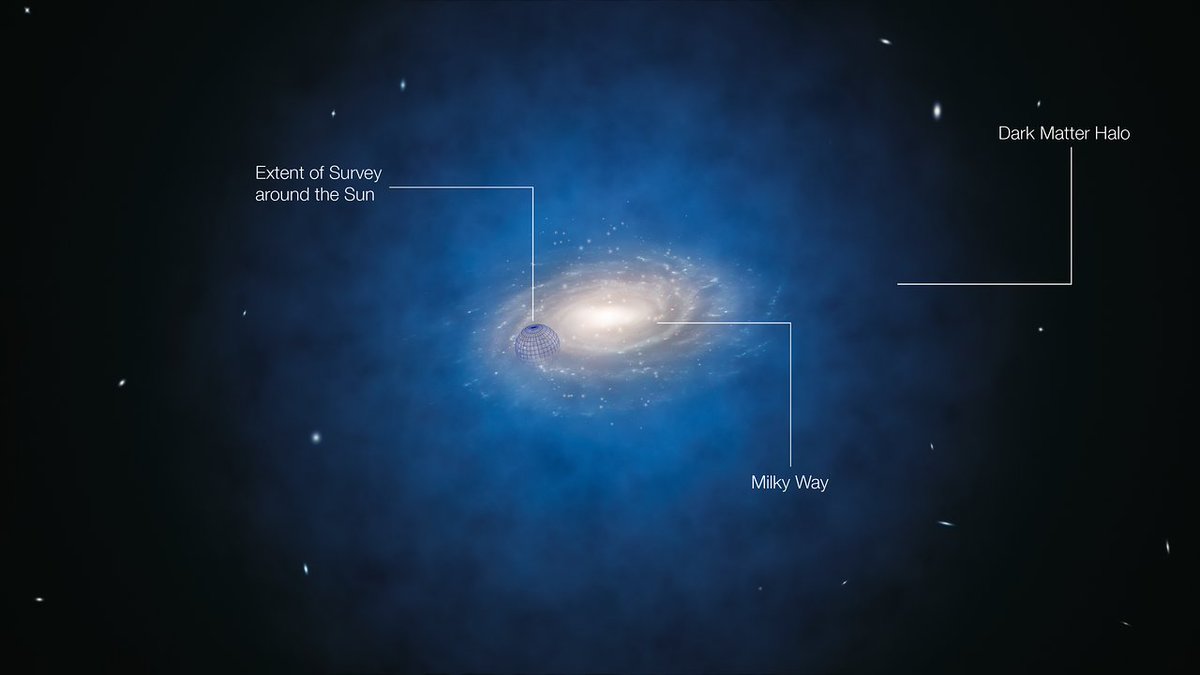"If dark matter exists, why can& #39;t we see its effects in the solar system?" is a question I& #39;m often asked. The answer: compared to the mass of the Sun, the mass of dark matter in our solar system is far too little to affect planet orbits like it does stars in galaxies. Here& #39;s how:
The solar system is big--REALLY big--from our perspective. But it& #39;s a tiny speck on the galactic scale. We can *very roughly* say there& #39;s ~1 star per pc³ in the galaxy (1 pc = 3.26 light-years). To compare, our solar system is ~100 AU in radius, which is only about 0.0005 pc.
So our entire solar system is just a tiny speck on the galaxy! There& #39;s *way more space* between stars than you& #39;d think. (Of course near the center of the galaxy stars are very densely packed due to gravity, and very sparse in the disk region).
Here& #39;s why that matters: the average density of dark matter near the solar system is ~0.008 solar masses per pc³. This + the radius of our solar system allows us to compute the total dark matter mass in it. What you& #39;ll find is there& #39;s only 4*10^-12 solar masses of dark matter.
That& #39;s incredibly tiny. Just to show you how tiny, Pluto is ~6.5*10^-9 solar masses. So the dark matter mass contribution to our solar system is negligible! Now, if I take a sphere of radius 1 pc, I& #39;ll get 0.008 solar masses of dark matter. Let& #39;s take a sphere of radius 100 pc.
In a sphere of 100 pc, you get over 33,000 solar masses worth of dark matter! That& #39;s how drastic the change is when you increase the volume. Also, the dark matter density changes with radius: it& #39;s very dense near the center, and the density decreases the further out you go.
And because the dark matter density changes with radius, I used the *local* average dark matter density rather than the average dark matter density for the entire galaxy.
Additionally, the dark matter halo is 3-4 times larger in diameter than the Milky Way disk (300,000 to 400,000 ly across, vs ~100,000 ly for the stellar disk). Accounting for this, you find that the mass in stars is ~10¹¹ solar masses, and the dark matter is a ~10¹² solar masses!
So yes, there& #39;s dark matter *everywhere*, yes, even in the solar system. But when you sum it up in a volume as small as the solar system, its mass is completely dwarfed by the mass of the Sun. Take much larger volumes, and you find a *huge* amount of dark matter!
To conclude, here& #39;s a visualization of the Milky Way and the surrounding dark matter halo so you can see just how enormous it is! The Universe is overwhelmingly full of dark matter, friends.
(Image credit: SO/L. Calçada)
(Image credit: SO/L. Calçada)

 Read on Twitter
Read on Twitter


